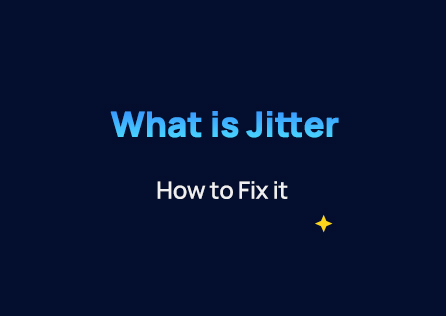What is Jitter, Why it Happens, and How to Fix it?
Wondering what is jitter?And why it happens? This article is all about jitter, its reasons, and why it is happening. Read till the end to learn these very basic concepts.
Introduction:
There is nothing worse than being on a phone call with a client when the line cuts out or their voice becomes choppy. If we're being completely honest, it makes you feel embarrassed and frustrated. even more so if it is not the first time. That is what Jitter is messing with you and this is where we will discuss that.

What is Jitter?
Any variation or displacement of the signal pulses in a high-frequency digital stream is known as a jitter. The discrepancy may be in the signal pulse's width, phase timing, or amplitude. Jitter can cause a display monitor to flicker, interfere with a desktop or server's capacity to function as intended by its CPU, introduce clicks or other undesirable effects in audio transmissions, and cause transferred data across network devices to be lost. The application has a big impact on how much jitter is acceptable.
Data packets are used to transfer any kind of information via the internet, including text, photos, audio, and video. Thousands of these packets carrying your voice or image are split up and routed to servers over the Internet; once there, they are reassembled.
Typically, data packets are transferred over a predetermined period at regular intervals. You might perceive jitter during a VoIP conversation or video meeting as sluggish audio or video or other obtrusive distortions when one of these data packets experiences a fluctuation or "packet delay variation" while being sent over your network connection.
When assessing the variability in ping, jitter is the variance in the time delay between when a signal is delivered and when it is received via a network connection. This is frequently brought on by hardware performance issues, network congestion, and a failure to apply packet prioritization. The longer the delay, the worse your VoIP and video services will perform during video conferences. VoIP jitter can cause calls to become choppy and uncoherent, or even drop out completely.
Why does Jitter happen?
In real-time communications, such as IP telephony and video conferencing, jitter is particularly problematic. For hosted desktops and virtual desktop infrastructure (VDI), it is also a severe issue. Jitter can cause unintentional deviations or inconsistencies in audio and video that lower the communication quality.
Several circumstances can lead to network jitter, which is a network performance issue on par with packet loss and latency. The most frequent cause of poor network performance is usually routers or modems or wireless networks in general. Hardware that performs poorly. A network jitter can be brought on by using an obsolete network with outdated switches, cables, or routers. Networks with high traffic volumes will operate poorly because there are too many active devices consuming the available capacity.
A wireless network's poor network connection is one of its downsides. The user experience (UX) of video and audio communication systems is improved when they are connected over a wired connection. Jitter happens especially for voice-over IP (VoIP) systems when audio data is not prioritized to be transmitted before other types of traffic.
What is Jitter Acceptable Level?
Low jitter levels are expected to have little impact on connectivity, thus even a tiny amount won't be a major issue. However, certain applications and services are more jitter-tolerant than others. For instance, voice changes are more susceptible to jitter than emailing. It ultimately boils down to what people are willing to bear in terms of data transfer inconsistencies and variations, even though poor audio and video quality negatively impacts user experience (UX).
How to Reduce Jitter?
1. A jitter buffer can reduce the effects of a jitter on a computer as well as in the network on a router or switch. In essence, the program consuming the network packets obtains them from the buffer rather than directly. The fluctuations in the timing of packets flowing into the buffer are smoothed out by feeding them out of the buffer at a regular rate.
2. Older cables and switches are one of the reasons for jitter. Because new cables can transport data at 250 megahertz (MHz), they may be able to eliminate ethernet jitter. Data transmission on older lines is limited to 125 MHz.
3. Minimizing unauthorized bandwidth usage during business hours. Jitter can become worse if a lot of bandwidth is used for non-work-related activities like network gaming or streaming videos.
4. Operating systems and applications should be updated after hours to free up resources for more important communications.
Wrapping Up:
Before we wrap our take on the question of “What is Jitter”, we can now summarize that Jitter is the variation in the latency of a packet flow between two systems in Internet Protocol (IP) networks when certain packets take longer to go from one system to the other. Route changes, time drift, and network congestion all contribute to jitter.
About The Author
The End